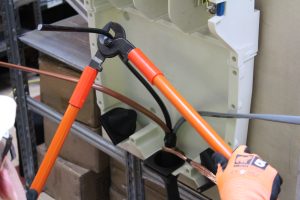Electrical Safety: The Non-Negotiable Foundation for Every Job
Date: April 25, 2025

Introduction
Working with electricity is an integral part of modern life and industry. From powering homes and businesses to enabling complex technological systems, skilled professionals are essential. However, this work carries inherent risks. Electrical hazards can cause severe injury or even fatalities if not managed correctly. That’s why a robust understanding and unwavering commitment to electrical safety aren’t just recommended—they are absolutely non-negotiable. This post revisits the core principles and practices that form the bedrock of safe electrical work.
Respect the Power: Fundamental Safety Principles
Before even touching a tool, certain mindsets and rules must be second nature:
- Treat Every Circuit as Live: Until proven otherwise through proper testing procedures, always assume a circuit is energized and dangerous. Complacency is the enemy of safety.
- Understand the Task: Thoroughly plan the job. Identify potential hazards, necessary precautions, and the sequence of operations before you start.
- Know Your Limits: Never attempt work beyond your skill level, training, or authorisation. If unsure, stop and seek guidance.
- Isolate and Verify: The gold standard is de-energisation. Implement proper Lockout/Tagout (LOTO) procedures to ensure circuits are off and cannot be accidentally re-energised while work is in progress. Crucially, always test with appropriate voltage testing equipment to confirm zero energy state after isolating and before starting work.
Common Electrical Hazards
Awareness is the first step in prevention. Key hazards include:
- Electric Shock: Occurs when the body becomes part of an electrical circuit. Severity depends on voltage, current path, and duration.
- Arc Flash: A sudden release of energy through the air when there’s a high-voltage gap or fault. Causes intense heat, light, pressure waves, and potential shrapnel – extremely dangerous.
- Burns: Can result from direct contact with live parts (electrical burns) or from the heat generated during an arc flash (thermal burns).
- Falls: Electric shock can cause muscle contractions leading to falls from height (ladders, platforms).
Essential Safe Work Practices
Beyond principles, practical steps are vital:
- Personal Protective Equipment (PPE): Always use appropriate PPE for the task and hazard level. This includes insulated gloves (check ratings and inspect before each use), eye protection (safety glasses/face shields), flame-resistant (FR) clothing where necessary, and safety footwear.
- Use the Right Tools: Standard tools conduct electricity. For any work on or near live parts (even after isolation, as a precaution), insulated hand tools rated for the voltage are essential. Ensure they meet standards like IEC 60900 and carry the VDE mark for tested safety. Regularly inspect insulated tools for damage (nicks, cuts, wear) – compromised insulation negates their protective properties.
- Test Before You Touch: Use a properly rated voltage tester or multimeter to verify de-energisation every time. Test your tester on a known live source before and after checking the circuit you’re working on (‘Live-Dead-Live’ test).
- Maintain a Safe Workspace: Keep the area clean, dry, and well-lit. Ensure clear access and egress. Use insulated matting where appropriate.
- Adhere to Regulations: Be familiar with and follow relevant national and local safety regulations and standards (e.g., HSE guidelines, BS 7671 Wiring Regulations in the UK).
The Critical Role of Insulated Tools
While de-energisation is the safest approach, insulated tools provide a crucial layer of protection against unexpected energisation or residual charge.
- Protection: Designed to protect the user from electric shock up to their specified voltage rating (typically 1000V AC / 1500V DC for VDE tools).
- Certification Matters: Look for tools clearly marked with the official 1000V rating, the double-triangle symbol, the year of manufacture, and ideally the VDE certification mark, confirming they’ve undergone rigorous testing according to IEC 60900.
- Not Just Any Coating: Proper insulated tools have multiple layers of durable, flame-retardant insulating material bonded to the tool. Simple plastic dip coatings are not sufficient for electrical safety.
Conclusion: Safety is Continuous
Electrical safety isn’t a one-time checklist; it’s an ongoing commitment. It requires constant vigilance, adherence to procedures, using the correct, well-maintained equipment, and continuous learning. Never cut corners when it comes to electricity. Prioritising safety protects not only yourself but also your colleagues and the public.
At Insulated Hand Tools, we supply high-quality, certified insulated tools because we believe professionals deserve equipment they can trust. Explore our range and invest in your safety – it’s the most important investment you can make.
Disclaimer: This blog post provides general information on electrical safety. Always refer to specific site procedures, risk assessments, relevant regulations (like the UK’s Electricity at Work Regulations 1989), and seek expert advice for your particular situation. Safe work practices should always be determined by qualified personnel.
